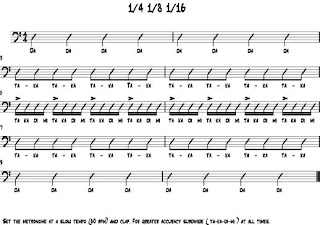Having spent over two decades playing music professionally, I have many thoughts on how to best put forward my ideas on how to become a better musician.
The best players in most fields are musically literate. I am aware of, and have worked with, some brilliant intuitive players, but they are the exception. Being musically literate means one is able to clearly interpret, and communicate, the music at hand, as no matter what the style there is always a framework within which musicians work. If each player in a group has a good level of understanding of the form being played they can perform at a higher level as a group.
Two important components of being musically literate are rhythm and harmony.
After spending many years counting the traditional way (say it with me 1 e & a, 2 e & a) I was introduced to a system called Konokol that facilitates a quicker and deeper understanding of rhythm. Konokol is the South Indian classical method of counting. It is a phonetic approach and allows the rhythms to be internalized quickly and communicated easily. A good approach is to say the rhythm, say and play it and then play it. With this oral/aural approach even challenging rhythms are easy to master at a slow tempos, then speeding them up is merely a matter of mechanics. The next step, reading the rhythms, is a relatively simple process made easier by the ability to say the phrases.
Harmony is the other building block. Again it is important to focus on an oral/aural methodology. Hearing the various notes within the chord, being able to identify and sing them (not like Pavarotti more like Tom Waits ;)) is vital to deciding what to play. There are a few harmonic progressions that form the basis for allot of music, so being able to hear them clearly aids greatly in ones playing.
Reading and writing music is important as it is a good way of archiving what has been learned. Just as we learned to speak before we could read I believe that this is the best way to approach music. Take away some of the mystique surrounding the notes and see them merely as a system of communication.
After the basics rhythm and harmony have been dealt with there are many avenues that can be pursued with greater ease.




